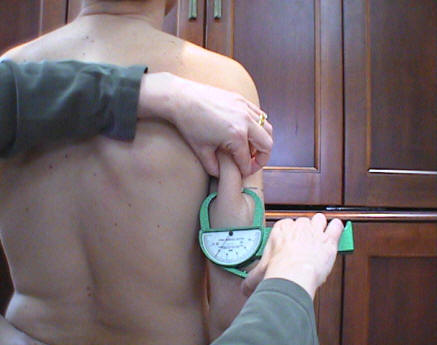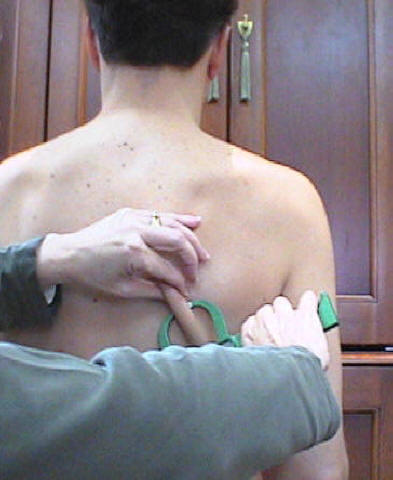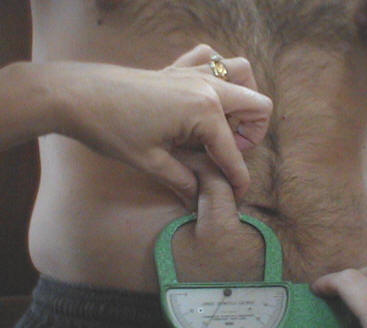| Anthropometric measurements can be used to differentiate body compartments of
fat tissue from lean tissue. Alterations in fat stores can help to identify
changes in nutritional status. Typical levels of fat and lean stores can be
compared to patient anthropometry to help assess nutritional status and
anticipate health problems related to malnutrition. Males carry approximately 15% of a healthy body weight as fat and females
have around 27% as fat. Fat stores can be classified as stored fat and essential
fat.11 Stored fat is used for energy and is found in and around
muscle, organs, and the gastrointestinal tract as well as under the skin
(subcutaneous fat). Stored fat can account for about 12% of body weight in men
and about 15% in women. Essential fat stores are required for normal metabolism
and are found in cell membranes, organs, bone marrow, mammary glands, and the
central nervous system. This type of fat is typically 3% of body weight in men
and 9% in women.
Approximately 34% of body fat is stored as subcutaneous fat in both men and
women.12 Fatfold measures (a double thickness of subcutaneous fat)
have been related to overall volume of body fat.13 An estimate of
body fatness can help to determine health risks related to body fatness,
including the severity of malnutrition. Usual fat-fold measures include those
shown in Table 5. While taking fatfold measures, the clinician’s fingers should
hold the fatfolds in a fashion that mimics the "C-shaped" pinch of calipers. See
Figures 11 through 15 (with table 5) for illustrations of methods. Table 6 shows
percentiles for triceps and subscapular fatfolds. Measures that fall below the
5th percentile or are above the 95th percentile suggest risk for
nutrition-related problems.
Table 5. Description of Methods Used
for Fatfold Measurements
|
Fat-Fold Measure |
Site |
Methods |
|
Triceps |
Back of arm at the midpoint between the acromion
process and olecranon process |
Measure with arm at side or with arm bent at elbow.
Start with your finger and thumb at either side of the mid-point of the
upper arm and gently apply pressure while pulling fingers toward the back of
the arm until the muscle pops out from underneath fingers and a double
fatfold remains. Gently place caliper about 1 cm from site being held and
allow to settle for about 3 seconds. Open the caliper while keeping in place
and allow it to settle twice more or until reading is repeatable. Record
reading to nearest millimeter. |
|
Biceps |
Front of arm on top of bicep at midpoint |
With arm bent at elbow and palm up in front of the
body, start with finger and thumb at either side of the mid-point of the
upper arm and gently apply pressure while pulling toward the back of the arm
until the muscle pops out from underneath fingers and a double fatfold
remains. Gently place caliper about 1 cm from site being held and allow to
settle for about 3 seconds. Open caliper while keeping in place and allow it
to settle twice more or until reading is repeatable. Record reading to
nearest millimeter. |
|
Subscapular |
At the lower angle point of the scapula bone |
Find the lower angle of the scapula bone (you can ask
the client to place arm behind their back at the waist and lift slightly to
allow the scapula bone to protrude). Allow the arm and shoulder to relax at
side of body. With fingers at 45-degree angle, place above and below the
angled base of the scapula and pull fatfold from above and below scapula
bone to form double thickness. Gently place caliper about 1 cm from site
being held and allow to settle for about 3 seconds. Open the caliper while
keeping in place and allow to settle twice more or until reading is
repeatable. Record reading to nearest millimeter. |
|
Suprailiac |
At top of the iliac bone at the mid-axillary line |
Find the iliac bone by running finger down from waist
toward the hip on the client’s right side. Have client fold right arm across
the front of the body for the measurement. With finger above and thumb below
at the angle of the iliac bone pull full double fatfold. Hold calipers at
the same angle and place caliper about 1 cm from finger and thumb and allow
to settle for about 3 seconds. Open the caliper while keeping in place and
allow to settle twice more or until reading is repeatable. Record to the
nearest millimeter. |
|
Abdominal |
One inch to the right of the belly button |
Place finger next to belly button and thumb about 1.5
inches to the right. Press in to pull full double fat fold at vertical.
Place caliper about 1 cm from finger and thumb and allow to settle for about
3 seconds. Open the caliper while keeping in place and allow to settle twice
more or until reading is repeatable. Record to the nearest millimeter. |
Figure 11. Illustration of Triceps
Fatfold

Figure 12. Illustration of Biceps
Fatfold

Table 6. Percentile Evaluation for
Triceps Fatfold Measures
|
Sex |
Age |
5th % |
25th % |
50th % |
75th % |
95th % |
|
Male |
18 |
4 |
6 |
9 |
13 |
24 |
|
19-24 |
4 |
7 |
10 |
15 |
22 |
|
25-34 |
5 |
8 |
12 |
16 |
24 |
|
35-44 |
5 |
8 |
12 |
16 |
23 |
|
45-54 |
6 |
8 |
12 |
15 |
25 |
|
55-64 |
5 |
8 |
11 |
14 |
22 |
|
>64 |
4 |
8 |
11 |
15 |
22 |
|
Female |
18 |
10 |
15 |
18 |
22 |
30 |
|
19-24 |
10 |
14 |
18 |
24 |
34 |
|
25-34 |
10 |
16 |
21 |
27 |
37 |
|
35-44 |
12 |
18 |
23 |
29 |
38 |
|
45-54 |
12 |
20 |
25 |
30 |
40 |
|
55-64 |
12 |
20 |
25 |
31 |
38 |
|
>64 |
12 |
18 |
24 |
29 |
36 |
Figure 13. Illustration of
subscapular fatfold

Table 7. Percentile Evaluation for
Subscapular Fatfold Measures (Medium Frame Size)
|
Sex |
Height |
5th
percentile |
50th percentile |
95th percentile |
|
Male |
62 |
|
13 |
|
|
63 |
|
18 |
|
|
64 |
|
17 |
|
|
65 |
8 |
16 |
32 |
|
66 |
7 |
16 |
33 |
|
67 |
8 |
18 |
33 |
|
68 |
7 |
16 |
31 |
|
69 |
7 |
16 |
31 |
|
70 |
7 |
15 |
30 |
|
71 |
7 |
14 |
30 |
|
72 |
7 |
15 |
32 |
|
73 |
8 |
15 |
32 |
|
74 |
|
14 |
|
|
Female |
58 |
|
23 |
|
|
59 |
10 |
29 |
43 |
|
60 |
8 |
22 |
41 |
|
61 |
7 |
19 |
42 |
|
62 |
7 |
18 |
40 |
|
63 |
7 |
18 |
38 |
|
64 |
7 |
16 |
38 |
|
65 |
7 |
15 |
38 |
|
66 |
7 |
14 |
35 |
|
67 |
7 |
15 |
37 |
|
68 |
8 |
15 |
35 |
|
69 |
|
12 |
|
Figure 14. Illustration of Suprailiac
Fatfold

Figure 15. Illustration of Abdominal
Fatfold

Additional evaluation of body fat can be performed once the circumferences
and fatfolds are obtained. Body density and arm fat area can be compared to
population norms to determine depletion or enhancement of lean or fat tissue.
Calculations are shown in Figures 16 through 18 and percentile evaluation of arm
fat area is shown in Table 8. Table 9 shows estimates of body fat percentages
using the sum of biceps, triceps, subscapular, and suprailiac fatfolds.
|
